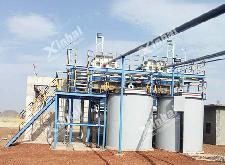

Warm Tip: If you want to know more details about equipment, solutions, etc, please click the button below for free consultation, or leave your requirements!

Wastewater in Thickener
In the previous article, we listed the composition of wastewater in the flotation plant and the hazards of harmful elements in it. Below, we will specifically introduce the treatment methods of tailings wastewater.
At present, the commonly used wastewater treatment methods in flotation plants include: natural purification, neutralization, coagulation sedimentation and oxidation treatment.
Due to its large area and being in the wild, the lead-zinc tailings pond has a strong natural purification effect on mineral processing wastewater. In a sense, it is a wastewater treatment plant. It has the following functions:
The dilution and purification effect of natural precipitation and stream water in the pond.
The mineral processing reagent is easily hydrolyzed in the wastewater pond, and its natural purification rate is 57% ~100%.
After the wastewater is discharged into the tailings pond, it will move regularly according to its specific gravity and particle size. The longer the wastewater stays in the pond, the higher its precipitation efficiency.
The tailings pond is a natural aeration device, which can not only oxidize and degrade various organic substances in wastewater, but also absorb and concentrate harmful heavy metal elements in the water.
About 80% of the key lead-zinc concentrators use the natural purification method of tailings ponds to treat wastewater.
Add alkali or acid to the wastewater for neutralization, so that the hydrogen ions and hydroxide ions react to form water. The harmful heavy metal ions in the wastewater will form hydroxide precipitates as the pH value is adjusted.
Fankou Concentrator adopts high alkalinity flotation process to separate ores. The pH value in the wastewater is 11.5 and the content of heavy metal ions is relatively high. Before the waste water is discharged, the concentrator stirs and neutralizes the sulfuric acid in the tailings pump tank to reduce the pH value of the waste water to about 9. After sulfuric acid treatment, the water quality reaches the waste water discharge standard, as shown in Table 1.
Wastewater Before and After Treatment in Fankou Lead-Zinc Flotation Plant(Unit:mg/t)
| Program | Lead | Zinc | Mercury | Cadmium | Arsenic | Suspended Solids | pH |
| Wastewater Before Treatment | 8.25 | 0.55 | 0.0025 | 0.012 | 0.123 | 114.5 | 11.5 |
| Wastewater After Treatment | 0.158 | 0.105 | 0.0007 | 0.0066 | 0.01 | 30.2 | 9~ |
This method uses the electrostatic neutralization of the coagulant and flocculant and bridging flocculation to remove colloidal substances in the wastewater to achieve the purpose of improving water quality.
The Tiantai lead-zinc mine uses iron sulfate and sulfuric acid to settle and flocculate the wastewater from the beneficiation, achieving ideal results. The treatment process is shown in Figure 2.
After the wastewater has been coagulated and settled for 24 hours, the final quality indicators of the water discharged are as follows: Pb2+ 0.1mg/t, Zn2+ 0.2mg/t, Cu2+ 0.1mg/t, Cd2+ 0.09mg/t, F- 4mg/t, S-0.1mg/t, COD25mg/t, pH=3. The water quality complies with the national industrial discharge standards.

Wastewater Treatment in Tiantai Lead-Zinc Flotation Plant
After flocculation, the wastewater can meet the requirements for reuse, but there is still a certain distance from the discharge standard, and it needs to be oxidized:
The xanthate in wastewater is unstable and easy to decompose. It can react with 02 and CO2 in the air and degrade into non-toxic compounds.
Experiments show that the self-cleaning effect of xanthate can reach 80%-90% under aeration conditions, and the 2# oil is more stable than xanthate, and can only reach 20% ~ 30%. Therefore, the removal of xanthate only needs to allow the waste water to fully contact the air to reach good removal effect, while the second oil needs to use the oxidant oxidation method.
We can oxidizers to wastewater to react with toxic organics in the wastewater and degrade them into environmentally harmless compounds. Many oxidants can be used to degrade organics, such as sodium hypochlorite, hydrogen peroxide, ozone, and bleaching powder.
To make sure no secondary pollutants will be brought in after adding the oxidant treatment, we can choose ozone as the oxidant for oxidation treatment.
Ozone can oxidize olefins into aldehydes and organic acids, and has a fairly strong oxidizing ability for 2# oil (a mixture of terpene acids and hydrocarbons).
Since the oxidation reaction of ozone in aqueous solution is catalyzed by OH gene, the pH value of wastewater is an important factor.
The above are the 4 methods commonly used in the treatment of wastewater from flotation plants. After the above treatment, the wastewater can meet the discharge standard and minimize the pollution to the environment.
If you have any questions about these methods, please leave a message, or contact our online customer service directly.
Last: Hazards of Mineral Processing Wastewater in Flotation Plant


What Are the Differences Between CIP and CIL?
 11269
11269
 0
0